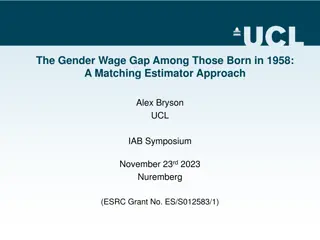Understanding Wage Principles in Economics
Compensation paid to employees for work is termed as wages and is typically based on an hourly basis. The relationship between real wages and money wages, as well as the concepts of nominal and real wages, are essential in understanding the dynamics of wages in economics.
Download Presentation

Please find below an Image/Link to download the presentation.
The content on the website is provided AS IS for your information and personal use only. It may not be sold, licensed, or shared on other websites without obtaining consent from the author. Download presentation by click this link. If you encounter any issues during the download, it is possible that the publisher has removed the file from their server.
E N D
Presentation Transcript
WAGE PRINCIPLES OF ECONOMICS BY JAHANAVI DEO DEPARTMENT OF COMMERCE M.L ARYA COLLEGE,KASBA B.COM 1_UNIT 9_DATE-31/07/2020
A wage is compensation paid to employees for work for a company during a period of time. Wages are always paid based on a certain amount of time. This is usually an hourly basis. This is where the term hourly worker comes from. Other forms of compensation include salary and commissions. Lower level employees are paid based on the amount of time worked. These employees usually have a time sheet or time card to keep track of the hours worked per week. Most modern employers have computerized systems to keep track of hourly employee hours. Employees must log into the system and log out to record their hours worked. Depending on the state, these employees are then paid once a week or once every other week. Hourly employees must receive overtime benefits if they work more than 40 hours each week.
Definitions Definitions A wage may be defined as the sum of money paid under contract by an employer to worker for services rendered. -Benham Wages is the payment to labour for its assistance to production. -A.H. Hansen Wage rate is the price paid for the use of labour. -Mc Connell A wage is price, it is the price paid by the employer to the worker on account of labour performed. -J.R. Turner
CONCEPTS OF WAGES The following are the two main concepts of wages: A. Nominal Wage: B. Real Wage: A. Money Wages or Nominal Wages: The total amount of money received by the labourer in the process of production is called the money wages or nominal wages. B. Real Wages: Real wages mean translation of money wages into real terms or in terms of commodities and services that money can buy. They refer to the advantages of worker s occupation, i.e. necessaries, comforts and luxuries of life which the worker can command in return for his services. the amount of the
An example will make the things clear. Suppose A receives Rs. 500 p.m. as money wages during the year. Suppose also that midway through the year the prices of commodities and services, that the worker buys, go up, on the average, by 50%. It means that though the money wages remain the same, the real wages (consumption basket in terms of commodities and services) are reduced by 50%. Real wages supplementary benefits along with the money wages. also include extra
Distinction between Real and Money Wages Distinction between Real and Money Wages 1. Relation with Price: Keeping all other things constant, there exists inverse relation between real wages and price i.e. with the increase in price level real wages tend to decline and vice-versa. 2. Money and Real Wages: Ceterus paribus, an increase in money wages will lead to an increase in real wages. It is due to the reason that with the increase in money wages, a labourer can purchase more goods and services than before. 3. Basic Difference: According to Adam Smith, money wages are paid in terms of the quantity of money whereas real w ages are paid in terms of necessaries of life. Therefore money w ages are expressed in terms of money and that of real wages in terms of goods and services.























